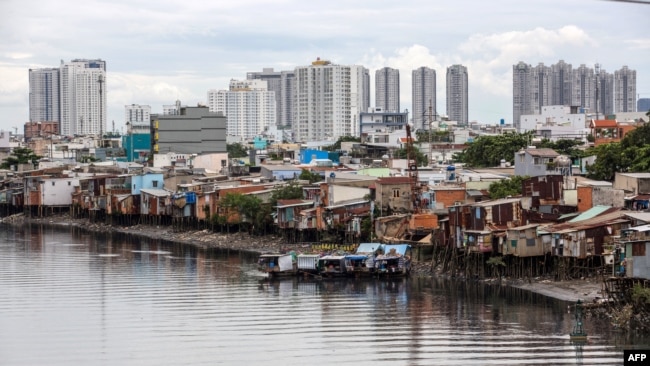연구: 아시아 해안 도시들이 가장 빠른 속도로 가라앉고 있습니다.
Study: Asian Coastal Cities Sinking at Fastest Rate
페이지 정보
작성자 Agence France-Presse 작성일 22-09-23 15:52 댓글 0본문

파일 - 2018년 9월 17일 베트남 호치민 시의 테 운하 둑에 집들이 보입니다. 남아시아와 동남아시아의 해안 도시들은 세계의 다른 곳보다 빠르게 가라앉고 있습니다.
FILE - Houses are seen on the banks of the Te canal in Ho Chi Minh City, Vietnam, Sept. 17, 2018. Sprawling coastal cities in South and Southeast Asia are sinking faster than elsewhere in the world.
인도 뉴델리입니다.
New Delhi, India —
남아시아와 동남아시아의 해안 도시들이 세계 다른 곳보다 빠르게 가라앉고 있으며, 수천만 명의 사람들이 해수면 상승에 더 취약하다고 새로운 연구가 밝혔습니다.
Sprawling coastal cities in South and Southeast Asia are sinking faster than elsewhere in the world, leaving tens of millions of people more vulnerable to rising sea levels, a new study says.
지난 주 Nature Sustainability 저널에 발표된 싱가포르 난양 기술 대학의 연구에 따르면, 급속한 도시화는 이러한 도시들이 급증하는 인구를 지원하기 위해 지하수를 많이 사용하는 것을 목격했습니다.
Rapid urbanization has seen these cities draw heavily on groundwater to service their burgeoning populations, according to research by Singapore's Nanyang Technological University, published in the journal Nature Sustainability last week.
"이것은 빠른 지방 침하를 겪고 있는 도시들을 기후로 인한 해수면 상승으로 인해 이미 존재하는 것보다 해안 위험의 더 큰 위험에 처하게 합니다."라고 연구는 말합니다.
"This puts cities experiencing rapid local land subsidence at greater risk of coastal hazards than already present due to climate-driven sea-level rise," the study says.
베트남에서 가장 인구가 많은 도시 중심이자 주요 비즈니스 중심지인 호치민은 매년 평균 16.2 밀리미터(0.6 인치)의 침하를 하고 있었으며, 전 세계 48개 대도시에서 위성 데이터를 조사한 조사에서 1위를 차지했습니다.
Vietnam's most populous urban center and main business hub, Ho Chi Minh City, was sinking an average of 16.2 millimeters (0.6 inches) annually, topping the study's survey of satellite data from 48 large coastal cities around the world.
방글라데시 남부 치타공 항구는 인도 서부 도시 아메다바드, 인도네시아 수도 자카르타, 미얀마의 상업 중심지인 양곤도 성수기에 20mm 이상 침몰하면서 2위를 차지했습니다.
The southern Bangladeshi port of Chittagong was second on the list, with the western Indian city Ahmedabad, Indonesian capital Jakarta and Myanmar's commercial hub Yangon also sinking more than 20 millimeters in peak years.
"빠르게 가라앉고 있는 많은 해안 도시들이 빠르게 거대 도시를 확장하고 있습니다. 조밀하게 건설된 건물 구조에서 지하수 추출 및 하중에 대한 높은 요구는 지역 땅 침하의 원인이 됩니다."라고 연구는 말합니다.
"Many of these fast-subsiding coastal cities are rapidly expanding megacities, where ... high demands for groundwater extraction and loading from densely constructed building structures, contribute to local land subsidence," the study says.
가라앉는 도시들 자체는 기후 변화의 결과가 아니지만, 연구원들은 그들의 연구가 이 현상이 "기후로 인한 평균 해수면 상승의 영향을 어떻게 더 복잡하게 만들 것인가"에 대한 더 나은 통찰력을 줄 것이라고 말했습니다.
Sinking cities are not of themselves a result of climate change, but researchers said their work would give a better insight into how the phenomenon would "compound the effects of climate-driven mean sea-level rise."
유엔 정부간 기후 변화에 관한 패널에 따르면, 2050년까지 10억 명 이상의 사람들이 해수면 상승의 위험이 있는 해안 도시에서 살 것이라고 합니다.
More than 1 billion people will live in coastal cities at risk of rising sea levels by 2050, according to the U.N. Intergovernmental Panel on Climate Change.
IPCC는 온실 가스 배출량이 급격히 감소하더라도, 세계 해수면은 금세기 말까지 최대 60센티미터(24인치)까지 상승할 수 있다고 말합니다.
The IPCC says that global sea levels could rise by up to 60 centimeters (24 inches) by the end of the century, even if greenhouse gas emissions are sharply reduced.
출처 : VOANews
댓글목록 0
등록된 댓글이 없습니다.

















